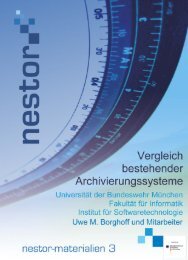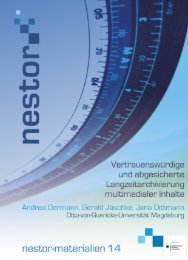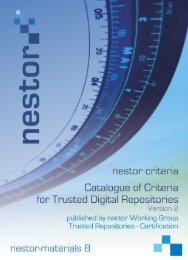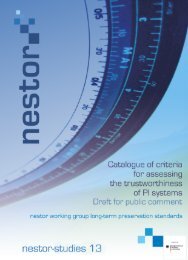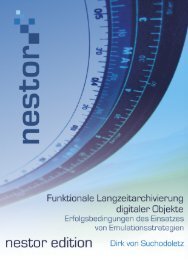Download (PDF, 9MB, Not barrier-free file.) - Nestor
Download (PDF, 9MB, Not barrier-free file.) - Nestor
Download (PDF, 9MB, Not barrier-free file.) - Nestor
- No tags were found...
You also want an ePaper? Increase the reach of your titles
YUMPU automatically turns print PDFs into web optimized ePapers that Google loves.
2.4.2 JUWEL Data ManagementThe structure of JUWEL information packages is currently defined by the DSpacestandard configuration. For AIPs, this implies in particular the structuring of items intobundles and bitstreams outlined above. The actual bitstreams are placed in the so-called“Bitstream Store” which is either the <strong>file</strong> system on the server or provided by a storagemanager (Storage Resource Broker, SRB). A bitstream's location in the <strong>file</strong> system isidentified by means of a “38-digit internal ID […] used to determine the exact location(relative to the relevant store directory) that the bitstream is stored in [...]” (Tansley et al.2006, 84). All of these components are linked by means of ID numbers which function askeys in the relational databases. 139 In addition, DSpace is capable of creating informationpackages for export containing, among others, an XML <strong>file</strong> with the metadata, the item'shandle, the license text <strong>file</strong>s as well as the content document(s).According to the DSpace wiki, among the changes planned for the DSpace 2.0release is also the implementation of an AIP Asset Store. Thus,[i]n the current architecture, all metadata is in a relational database, and all content bitstreamsare in the <strong>file</strong> system on the server. This makes certain preservation-related activities complex,including backups, auditing, and replication/distribution. The proposed new asset store storesmetadata and content together as standards-based Archival Information Packages OAISterminology. This does not replace the current relational database in DSpace. Although theseAIPs are the authoritative version of information in the system, the relational database andsearch indices are still used for performant access; however, these are considered caches ofthe information in the AIPs […].An AIP consists of:- A core metadata METS document, conforming to the DSpace AIP METS pro<strong>file</strong> [...].- Zero or more bitstreams. These may be content <strong>file</strong>s (which are in the <strong>file</strong> manifest of theMETS document), or additional metadata (referred to by the METS document).- A checksum for the METS. (DSpace Wiki 2009) 140While this Asset Store DSpace on the one hand makes an effort to further OAISimplementationby creating actual AIPs rather than storing the information only in therelational databases. At the same time however, this might lead to storing the checksumand the digital object which it describes in one container, which would not be inaccordance with the TRAC catalog of criteria. In addition, as the relational database is toremain functional, it might become more complex to establish the integrity of theinformation stored in the repository: thus, not only referential integrity of the database hasto be monitored, but in addition it has to be ascertained that database and asset store donot deviate from each other in terms of the information they contain.As mentioned in above quotation, a METS pro<strong>file</strong> will be available for DSpace AIPs.Similarly, a METS pro<strong>file</strong> for SIPs has been proposed in order to answer to “a need toprepare a METS pro<strong>file</strong> or pro<strong>file</strong>s that will govern the creation of the three types ofcontent 'packages' defined by the [OAIS] reference model” (DSpace Wiki 2008b). Thus,139 A graphical visualization of the relational database is available athttp://dspace.cvs.sourceforge.net/dspace/dspace/docs/image/db-schema.gif?view=markup – 30.10.2009.140 Please note that the page is currently marked as requiring an update. It is, however, not transparentwhich information exactly needs to be updated.57



